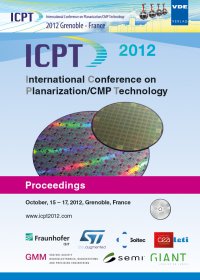Role of Abrasive Type and Media Surface Energy on Nanoparticle Adsorption
Conference: ICPT 2012 - International Conference on Planarization / CMP Technology
10/15/2012 - 10/17/2012 at Grenoble, France
Proceedings: ICPT 2012
Pages: 6Language: englishTyp: PDF
Personal VDE Members are entitled to a 10% discount on this title
Authors:
Kaiser, Jordan; Streit, Michael; Keleher, Jason J. (Department of Chemistry, Lewis University, Romeoville, IL 60446, USA)
Connor, Patrick (Pall Corporation, Port Washington, NY 11050, USA)
Levy, Patrick (Pall Corporation, Timonium, MD 21093, USA)
Abstract:
Previous work has shown that the behavior of filters with respect to their use in removing large particles from CMP slurries depends greatly upon the nature of the slurry and the nature of the filter. This work highlighted a significant interaction between abrasive particles and polypropylene, which constitutes most filters used in CMP slurry filtration process. More specifically this work determined that the nature of the abrasive particle and the conditions had a significant effect on the binding/adsorption to the polymer filter media. These results can provide guidance when designing filtration for specific slurry types, or recommending specific filter grades or modes of usage, so as to optimize efficiency and life. Using modified attenuated total reflectance (ATR) infrared spectroscopic and quartz crystal microbalance (QCM) techniques this work will further probe the relationship between abrasive-type and the subsequent interaction with polypropylene. Results have shown a significant difference in the nature of the interaction under conditions that mimic the presence of abrasive particles or their agglomerates that are already captured in the depth of the filtration medium. This paper focuses on gaining mechanistic understanding around the synergy between nanoparticles and filtration media that have modulated surface energy. Keywords: silica, filtration, CMP, slurry, ATR, QCM, adsorption, polypropylene.


